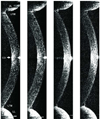Reduced tear meniscus dynamics in dry eye patients with aqueous tear deficiency
- PMID: 20378096
- PMCID: PMC2878896
- DOI: 10.1016/j.ajo.2010.01.004
Reduced tear meniscus dynamics in dry eye patients with aqueous tear deficiency
Abstract
Purpose: To measure the tear meniscus dynamics in aqueous tear deficiency dry eye patients using optical coherence tomography.
Design: Clinical research study of a laboratory technique.
Methods: Twenty-five aqueous tear deficiency dry eye patients and 30 healthy subjects were recruited. Upper and lower tear menisci of 1 randomly selected eye of each participant were imaged during normal and delayed blinking using optical coherence tomography. Measured parameters included upper tear meniscus height and volume, lower tear meniscus height and volume, the blink outcome defined as the meniscus volume change during blink action, and open eye outcome defined as the meniscus volume change during the open eye period.
Results: During normal blinking, both tear meniscus height and volume before blink in dry eye patients were significantly smaller than those in healthy subjects, except for the upper tear meniscus volume. During normal blinking, the blink outcome and open eye outcome of lower tear meniscus were significantly smaller in dry eye patients compared with healthy subjects. During delayed blinking, the upper and lower tear menisci heights and volumes significantly increased in both groups. However, dry eye patients had smaller increases than healthy subjects. During delayed blinking, the open eye outcomes of upper and lower tear menisci were smaller in dry eye patients than healthy subjects.
Conclusions: Dry eye patients seem to have reduced tear meniscus dynamics during normal blinking and smaller increases of meniscus volume during delayed blinking. Analysis of tear meniscus dynamics may provide more insight in the altered tear system in dry eye patients.
Copyright 2010 Elsevier Inc. All rights reserved.
Figures




Similar articles
-
Upper and lower tear menisci in the diagnosis of dry eye.Invest Ophthalmol Vis Sci. 2009 Jun;50(6):2722-6. doi: 10.1167/iovs.08-2704. Epub 2009 Feb 14. Invest Ophthalmol Vis Sci. 2009. PMID: 19218609
-
Tear meniscus volume in dry eye after punctal occlusion.Invest Ophthalmol Vis Sci. 2010 Apr;51(4):1965-9. doi: 10.1167/iovs.09-4349. Epub 2009 Nov 20. Invest Ophthalmol Vis Sci. 2010. PMID: 19933200
-
Clinical significance of tear menisci in dry eye.Eye Contact Lens. 2012 May;38(3):183-7. doi: 10.1097/ICL.0b013e318252ce0c. Eye Contact Lens. 2012. PMID: 22543731
-
Age-related changes in tear menisci imaged by optical coherence tomography.Optom Vis Sci. 2011 Oct;88(10):1214-9. doi: 10.1097/OPX.0b013e3182271297. Optom Vis Sci. 2011. PMID: 21705939
-
Tear Film Dynamics in Visual Display Terminal Users: A Review of Impact on Goblet Cells, Lacrimal and Meibomian Gland Function.Semin Ophthalmol. 2025 May;40(4):306-319. doi: 10.1080/08820538.2024.2332355. Epub 2024 Apr 17. Semin Ophthalmol. 2025. PMID: 38629642 Review.
Cited by
-
Diagnostic Performance of Visionix VX120+ Platform for Dry Eye Screening.Diagnostics (Basel). 2024 Oct 12;14(20):2276. doi: 10.3390/diagnostics14202276. Diagnostics (Basel). 2024. PMID: 39451598 Free PMC article.
-
Differences in Central Corneal Thickness between Spectral Domain-Optical Coherence Tomography and Ultrasound Pachymetry in Patients with Dry Eye Disease.J Ophthalmol. 2016;2016:2623719. doi: 10.1155/2016/2623719. Epub 2016 Jun 8. J Ophthalmol. 2016. PMID: 27375899 Free PMC article.
-
Evaluation of ocular surface in children with attention deficit hyperactivity disorder with respect to methylphenidate treatment.Arq Bras Oftalmol. 2022 Sep 23;87(2):0290. doi: 10.5935/0004-2749.2021-0290. eCollection 2022. Arq Bras Oftalmol. 2022. PMID: 36169433 Free PMC article. Clinical Trial.
-
Changes of Ocular Surface and the Inflammatory Response in a Rabbit Model of Short-Term Exposure Keratopathy.PLoS One. 2015 Sep 3;10(9):e0137186. doi: 10.1371/journal.pone.0137186. eCollection 2015. PLoS One. 2015. PMID: 26334533 Free PMC article.
-
Correlation between optical coherence tomography-derived assessments of lower tear meniscus parameters and clinical features of dry eye disease.Cornea. 2012 Jun;31(6):680-5. doi: 10.1097/ICO.0b013e3182261577. Cornea. 2012. PMID: 22378111 Free PMC article.
References
-
- Lemp MA. Advances in understanding and managing dry eye disease. Am J Ophthalmol. 2008;146:350–356. - PubMed
-
- Doane MG. Interactions of eyelids and tears in corneal wetting and the dynamics of the normal human eyeblink. Am J Ophthalmol. 1980;89:507–516. - PubMed
-
- Doane MG. Blinking and the mechanics of the lacrimal drainage system. Ophthalmology. 1981;88:844–851. - PubMed
-
- Sahlin S, Laurell CG, Chen E, Philipson B. Lacrimal drainage capacity, age and blink rate. Orbit. 1998;17:155–159. - PubMed
-
- Sahlin S, Chen E. Gravity, blink rate, and lacrimal drainage capacity. Am J Ophthalmol. 1997;124:758–764. - PubMed
Publication types
MeSH terms
Grants and funding
LinkOut - more resources
Full Text Sources
Medical

